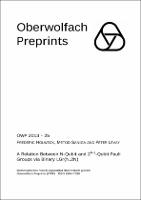Zusammenfassung
Employing the fact that the geometry of the $N$-qubit ($N\geq 2$) Pauli group is embodied in the structure of the symplectic polar space $\mathcal{W}(2N-1, 2)$ and using properties of the Lagrangian Grassmannian $LGr(N, 2N)$ defined over the smallest Galois field, it is demonstrated that there exists a bijection between the set of maximum sets of mutually commuting elements of the $N$-qubit Pauli group and a certain subset of elements of the $2^{N-1}$-qubit Pauli group. In order to reveal finer traits of this correspondence, the cases $N=3$ (also addressed recently by Lévay, Planat and Saniga (JHEP 09 (2013) 037)) and $N=4$ are discussed in detail. As an apt application of our findings, we use the stratification of the ambient projective space $PG(2^N-1, 2)$ of the $2^{N-1}$-qubit Pauli group in terms of $G$-orbits, where $G\equiv SL(2,2) \times SL(2,2) \times \cdot \cdot \cdot \times SL(2,2) \rtimes S_N$, to decompose $\underline{\pi}(LGr(N,2N))$ into non-equivalent orbits. This leads to a partition of $LGr(N, 2N)$ into distinguished classes that can be labeled by elements of the above-mentioned Pauli groups.

